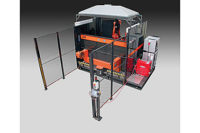
Every generation of engineers experiences a breakthrough technology that radically changes the way they design and assemble products. For example, computers, plastics and robotics transformed the engineering profession back in the 1970s.
Future engineers may say the same thing about an evolving technology that holds tremendous promise. Compliant mechanisms contain a single-piece flexible structure that elastically deforms without joints to produce desired functionality.
Traditionally, automobiles, airplanes, refrigerators and other products contain a wide variety of rigid parts connected by joints that are designed to be strong and stiff. As a result, assembly often accounts for more than 40 percent of labor cost and approximately 50 percent of manufacturing cost.
According to Sridhar Kota, Ph.D., a professor of mechanical engineering at the University of Michigan who is a leading expert on the topic, compliant mechanisms stretch the well-known design for assembly methodology to its limit-ideally, a single part with no assembly necessary. Fewer parts translate into greater cost savings, better quality and higher reliability.
“A compliant structure is a monolithic joint-less mechanism that exploits the elasticity of material to produce a desired functionality, such as force or motion transmission, motion guidance, shape morphing, or energy storage and release,” says Kota, who serves as director of the Compliant Systems Design Lab. “A compliant system has actuators and sensors integrated with the compliant structure or transmission.”
The arrangement of the material within the compliant mechanism is optimized so that compliance is distributed through small strains to produce large deformations. Compliant mechanisms are unique, because they can achieve the motion and functionality of conventional mechanisms, but have no moving parts.
“Compliant mechanisms gain their motion from the deflection of their parts rather than traditional components like joints, hinges, springs and bearings,” adds Larry Howell, Ph.D., a professor of mechanical engineering at Brigham Young University. “This provides several advantages, including decreased cost due to low part count, and reduced or eliminated assembly.
“[Other benefits include] high performance [due to] high precision, low wear and low backlash,” claims Howell, who heads the Compliant Mechanisms Research Group. “[In addition, compliant mechanisms can be] easily miniaturized, including devices at the micro and nano level.”
Virtually any product with multiple mechanical parts performing a motion function is a candidate for compliant mechanisms. Parts can be fabricated from a wide range of materials, including steel, aluminum, titanium, plastics and composites.
“The best materials have a high strength-to-modulus ratio or high strength and low stiffness,” claims Howell. “Compliant mechanisms can be made out of many different materials, depending on the application.
“Titanium has really nice properties for many high-end applications,” Howell points out. “Beryllium copper [can be used] for applications that conduct electricity, [while] polypropylene is great for parts to be injection molded. We’ve also used pure silicon for microscopic, on-chip applications.”

This parallel-guiding compliant mechanism was fabricated from a planar sheet of material.
Old Concept, New Uses
The basic technology behind compliant mechanisms has been around for many years. “The first research was conducted more than a decade ago,” says George Hazelrigg, deputy division director for civil, mechanical and manufacturing innovation at the National Science Foundation. Hazelrigg was responsible for funding Kota’s initial research in the mid-1990s.In addition to simpler construction, compliant structures have unique qualities that give them higher fatigue life and reliability. “The technology enables significant weight reduction due to lack of bulky hinges, pins, springs and other mechanical components, which appeals to many manufacturers,” Hazelrigg points out. “It’s always simpler, cheaper and easier to build something that only needs one component vs. 10 parts.”
According to Howell, the basic technology behind compliant mechanisms is in widespread use today. “There are many compliant mechanisms currently on the market, including simple everyday devices such as ketchup lids that snap between open and closed positions,” he explains. “More sophisticated devices include Texas Instruments’ DLP projector, which uses microscopic compliant torsion hinges to obtain the mirror motion.”
As engineers become more aware of compliant mechanisms and their advantages, Howell says “we are seeing an increased interest and an acceleration of [the technology].” Recent applications that Howell and his colleagues have been involved with include spinal implants, exercise equipment, electrical connectors, overrunning clutches, centrifugal clutches, switches, high-end bike brakes, sporting goods and mechanical components used in handheld electronics.
Howell believes that Toyota’s recent gas pedal recall nightmare could have been avoided if engineers designed the part as a compliant system. Instead, they used interlocking plastic teeth designed to provide tension on the pedal; whenever moisture was present, this flaw caused the pedals to stick. “A compliant mechanism could solve that problem, because it offers infinite fatigue life,” Howell points out.

This shape-morphing wing can flex its trailing edge up or down 10 degrees.
Future Applications
FlexSys Inc. is currently commercializing the technology developed at the University of Michigan’s Compliant Systems Design Lab. It claims to be the only company in the world that’s designing systems that use compliant mechanisms. Most of FlexSys’ designs are monolithic-a single stamping or molding operation can produce a finished component.
“In the case of an assembly, efforts are taken to reduce the number of components through novel design,” claims Gregory Ervin, operations manager. “This is demonstrated in the FlexSys monolithic windshield wiper.”
The complaint wiper has no flexural joints or living hinges, which eliminates the need for assembly operations altogether. It uses only one part vs. more than 12 components on a traditional wiper subassembly.
“Such a design with an integrated arm designed for a rear wiper costs 35 percent less when manufactured in the U.S. compared to a conventional wiper imported from China today,” Ervin points out. Unlike traditional metal and plastic snap-fit designs, the one-piece windshield wiper evenly distributes pressure over the blade and conforms to any glass shape, from flat to highly curved.
The wipers are expected to be commercially available some time next year. A Tier One supplier and an OEM are currently working on its implementation. FlexSys has also developed a compliant side-view mirror and has patented single-piece mechanical motion amplifiers.
In addition, the company is actively pursuing a wide variety of aerospace applications, such as wing flaps, ailerons, rotor blades and other aircraft control surfaces. The goal is better fatigue life, in addition to aircraft that are more fuel efficient and maneuverable.
According to Ervin, traditional mechanical flaps on the trailing edge of aircraft wings disrupt airflow and increase aerodynamic drag, which increase fuel consumption. The FlexSys wing can flex its trailing edge up or down 10 degrees. Air flows smoothly over the seamless wing, which uses internal actuators to alter its shape as conditions change.
“The U.S. Air Force has invested $6 million to test our shape-morphing aircraft wings,” says Ervin. “The adaptive compliant trailing edge technology that FlexSys has developed to replace conventional commercial aircraft control surfaces is currently being developed for integration and flight testing on a Gulfstream business jet.” NASA’s Dryden Flight Research Center is working with Air Force engineers on the project.
Several commercial aircraft companies have also enquired about adopted the technology. “However, the development process for aircraft applications is rather lengthy and it will be several years before the technology is implemented on a commercial aircraft,” Ervin points out. “We have also developed shape-morphing rotor blades for helicopters.”
This same technology is being adapted for use in other industries. For instance, next-generation composite wind turbine blades equipped with flexible leading edges can capture up to 15 percent more energy and reduce stress loads. FlexSys is working with engineers at Sandia National Laboratory on the technology, which should be ready for widespread use within three years.
Despite all the advantages of compliant mechanisms, engineers face several challenges. “Compliant mechanisms often integrate multiple functions into fewer parts, which provides many advantages, but also makes their design very difficult,” says Howell. “One of the most critical aspects is to design them for acceptable fatigue life for the given application.”
However, researchers have developed sophisticated algorithms and CAD tools to optimize compliant design. “Once an application, desired materials and manufacturing method are identified, [we] can generate alternate solutions and quickly evaluate the merits and shortcomings of a compliant mechanism,” says Kota. “Some applications can be quickly ruled out because of operational or manufacturing constraints.” A
To learn more about compliant design, click www.assemblymag.com and search for:
“In the case of an assembly, efforts are taken to reduce the number of components through novel design,” claims Gregory Ervin, operations manager. “This is demonstrated in the FlexSys monolithic windshield wiper.”
The complaint wiper has no flexural joints or living hinges, which eliminates the need for assembly operations altogether. It uses only one part vs. more than 12 components on a traditional wiper subassembly.
“Such a design with an integrated arm designed for a rear wiper costs 35 percent less when manufactured in the U.S. compared to a conventional wiper imported from China today,” Ervin points out. Unlike traditional metal and plastic snap-fit designs, the one-piece windshield wiper evenly distributes pressure over the blade and conforms to any glass shape, from flat to highly curved.
The wipers are expected to be commercially available some time next year. A Tier One supplier and an OEM are currently working on its implementation. FlexSys has also developed a compliant side-view mirror and has patented single-piece mechanical motion amplifiers.
In addition, the company is actively pursuing a wide variety of aerospace applications, such as wing flaps, ailerons, rotor blades and other aircraft control surfaces. The goal is better fatigue life, in addition to aircraft that are more fuel efficient and maneuverable.
According to Ervin, traditional mechanical flaps on the trailing edge of aircraft wings disrupt airflow and increase aerodynamic drag, which increase fuel consumption. The FlexSys wing can flex its trailing edge up or down 10 degrees. Air flows smoothly over the seamless wing, which uses internal actuators to alter its shape as conditions change.
“The U.S. Air Force has invested $6 million to test our shape-morphing aircraft wings,” says Ervin. “The adaptive compliant trailing edge technology that FlexSys has developed to replace conventional commercial aircraft control surfaces is currently being developed for integration and flight testing on a Gulfstream business jet.” NASA’s Dryden Flight Research Center is working with Air Force engineers on the project.
Several commercial aircraft companies have also enquired about adopted the technology. “However, the development process for aircraft applications is rather lengthy and it will be several years before the technology is implemented on a commercial aircraft,” Ervin points out. “We have also developed shape-morphing rotor blades for helicopters.”
This same technology is being adapted for use in other industries. For instance, next-generation composite wind turbine blades equipped with flexible leading edges can capture up to 15 percent more energy and reduce stress loads. FlexSys is working with engineers at Sandia National Laboratory on the technology, which should be ready for widespread use within three years.
Despite all the advantages of compliant mechanisms, engineers face several challenges. “Compliant mechanisms often integrate multiple functions into fewer parts, which provides many advantages, but also makes their design very difficult,” says Howell. “One of the most critical aspects is to design them for acceptable fatigue life for the given application.”
However, researchers have developed sophisticated algorithms and CAD tools to optimize compliant design. “Once an application, desired materials and manufacturing method are identified, [we] can generate alternate solutions and quickly evaluate the merits and shortcomings of a compliant mechanism,” says Kota. “Some applications can be quickly ruled out because of operational or manufacturing constraints.” A
To learn more about compliant design, click www.assemblymag.com and search for:
- The Wrights Had It Right.





